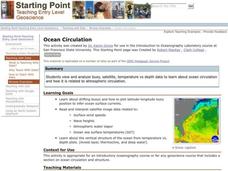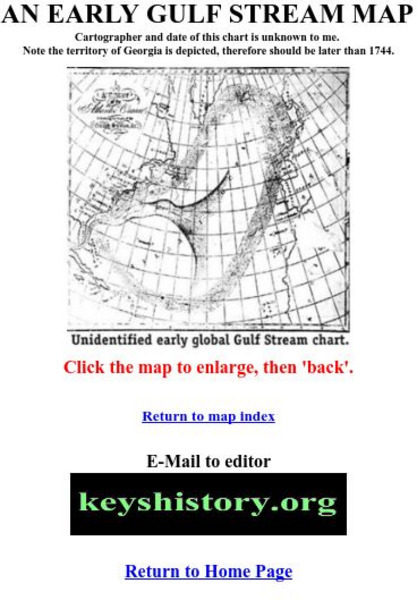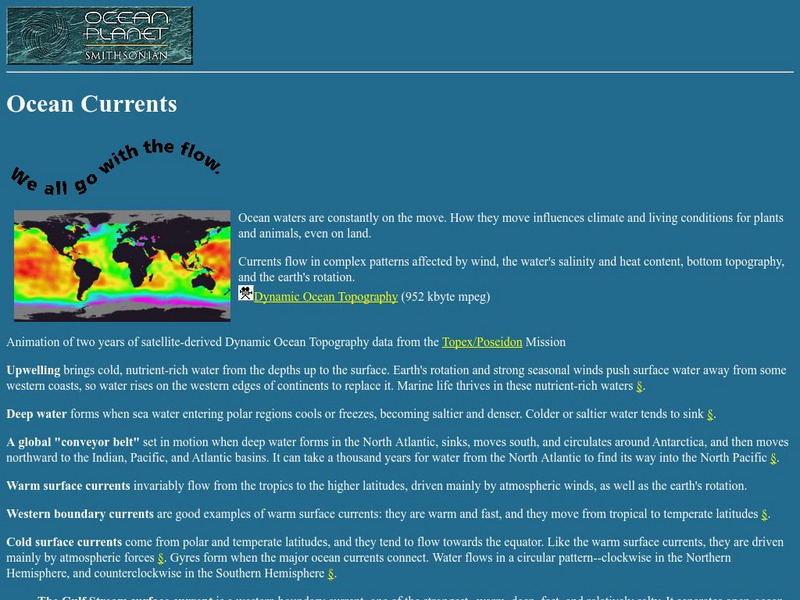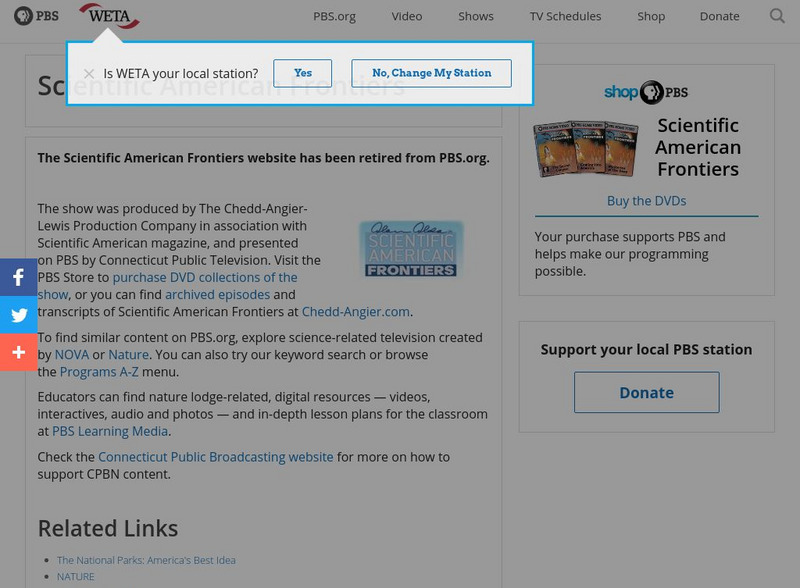Curated OER
Upwelling - Cold One Day, Warm Another?
Discuss with your oceanographers what forces cause nearshore upwelling and downwelling. Display a line of wind vectors alongside a graph of the temperatures so that they can discover whether or not they are related. Discussion questions...
Curated OER
Follow Your Dreams: Career Goals
It is so important for impending high school graduates to start thinking about their potential careers. Here, they discuss the persistence of Blondie Hasler and his impressive transatlantic trip. They follow various routes on a map and...
Curated OER
Extreme Climate
Students discuss global warming, greenhouse effect, permafrost and other key words. In this climate lesson students create a web that connects global warming, the Arctic and world climate then write a paragraph explaining the role...
Curated OER
Weather Lesson
Students examine the various types of dangerous weather situations. In groups, they focus on the characteristics of a nor'easter and how it forms. They compare and contrast the two main types of nor'easters and examine how one can use...
Curated OER
Dig Into Ireland
Students explore environments and wildlife of Ireland to find out how they were formed, and how they helped form Irish culture. Students research online to determine connections between present elements in Irish culture and wildlife and...
Curated OER
Ocean Circulation
Students view and analyze buoy, satellite, temperature vs depth data to study about ocean circulation and how is related to atmospheric circulation. They read and interpret satellite image data related to: Surface wind speeds, Wave...
Curated OER
Hurricane and Tornadoes Vocabulary
Quiz your young meteorologists using this simple matching worksheet. Learners inventory 16 weather-related terms, matching them to the appropriate definition on the right. There are an equal number of definitions as there are terms. A...
Curated OER
Biomes: Extreme Climate
Middle schoolers discuss the causes of global warming. In this earth science lesson, students examine how global warming is connected to the arctic and world climate. They write a paragraph about their interconnection.
Curated OER
PASSWORD VOCABULARY REVIEW
Students write definitions for vocabulary words used in a unit in any subject area. They use the words to play a game.
Curated OER
What Was for Dinner?
Students examine energy obtaining strategies that are used by organisms in deep reef communities. In this ocean lesson students complete an isotope activity.
Curated OER
Water, Water Everywhere, and Nary a Drop to Drink!
Students sing the continent song and locate oceans between the continents on a map. They read "They Earth is Mostly Ocean" and copy notes into their journals. They watch a demonstration of water and saltwater evaporated to see what is...
PBS
Pbs Learning Media: What Causes the Gulf Stream?
This video segment adapted from NOVA uses satellite imagery to illustrate the Gulf Stream's path and animations to explain how atmospheric phenomena cause it to move. [1:51]
Other
Florida Keys History Museum: An Early Gulf Stream Map
This is one of the earliest maps of the Gulf Stream, probably after 1744.
Smithsonian Institution
National Museum of Natural History: Ocean Planet: Ocean Currents
The Ocean Planet exhibit at the Smithsonian explains the general features of ocean circulation. A general look at upwelling, deep water, and currents are combined for an overall view.
Science Buddies
Science Buddies: Ocean Currents: Modeling 'Global Conveyor Belt' in Your Kitchen
Ocean currents have a profound effect on the climates of the continents, especially those regions bordering on the ocean. The Gulf Stream makes northwest Europe much more temperate than any other region at the same latitude, and the...
CK-12 Foundation
Ck 12: Earth Science: How Ocean Currents Moderate Climate
[Free Registration/Login may be required to access all resource tools.] Looks at how ocean currents transfer heat from one place to another.
Museum of Science
Museum of Science: Ocean Currents
An introduction to ocean motion that focuses on ocean currents. Includes instructions for conducting an experiment to further understanding.
The History Cat
The History Cat: Geography Phenomenon: Hurricanes
Describes how ocean currents affect climates around the world and the impact of the Gulf Stream, which can cause hurricanes to form. The role of wind patterns in the Caribbean is also discussed.
Texas A&M University
Ocean World: Bringing the Ocean to the Classroom
Online resource for students and teachers to see information on icebergs, fisheries, coral reefs, waves, currents and more. Provides teachers with learning activities. Has its own ask-an-expert site (Ask Dr. Bob), and provides real-time...
Other
Steve Spangler Science: Denver's Brown Cloud
Learn how fluids move through our atmosphere and water. This experiment explains atmospheric convection currents (thunderstorms), the Gulf Stream, and temperature inversion. A video is included.
PBS
Pbs Teachers: Expedition Panama: Bridge That Changed the World
Investigate the Coriolis effect on the directional flow of currents by measuring linear speeds at different places on the globe. Create a timeline demonstrating geologic time.
Center for Educational Technologies
Nasa: Classroom of the Future: Spheres: Hydrosphere
Use this site to learn about the millions and trillions of gallons of water that covers the earth, known as the hydrosphere.




















